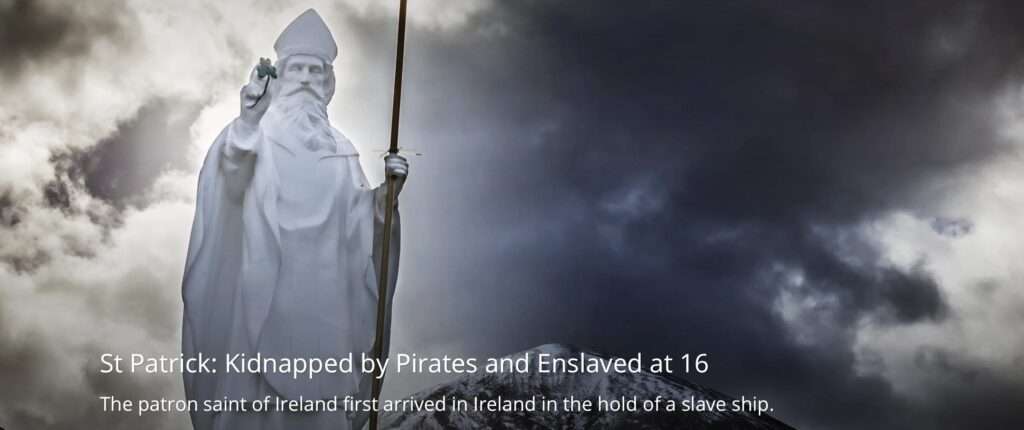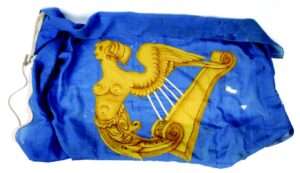By Carol Fisher Linn
 The time is nearing for the traditional wearing of the green as we approach St. Patrick’s Day on March 17. Here’s something interesting about the fact that we wear green to celebrate this venerated patron saint of Ireland. You see, according to historians his color was blue, not green. The color, called St. Patrick’s blue is a lighter shade, and can still be seen on vintage Irish flags. The blue color was used by the Irish Citizen Army … the same guys who attempted to end British rule in the 1916 Easter Uprising. But, according to a March 16, 2010, piece in Time magazine the use of green started with the humble clover which was a symbol of Irish nationalism during the 1798 Irish Rebellion. Wearing clover pins became a regular practice and before long, the color spread to their uniforms. Between that and the color of the verdant green fields that cover Ireland, green won out and blue was relegated to the history bin.
The time is nearing for the traditional wearing of the green as we approach St. Patrick’s Day on March 17. Here’s something interesting about the fact that we wear green to celebrate this venerated patron saint of Ireland. You see, according to historians his color was blue, not green. The color, called St. Patrick’s blue is a lighter shade, and can still be seen on vintage Irish flags. The blue color was used by the Irish Citizen Army … the same guys who attempted to end British rule in the 1916 Easter Uprising. But, according to a March 16, 2010, piece in Time magazine the use of green started with the humble clover which was a symbol of Irish nationalism during the 1798 Irish Rebellion. Wearing clover pins became a regular practice and before long, the color spread to their uniforms. Between that and the color of the verdant green fields that cover Ireland, green won out and blue was relegated to the history bin.

Since I’m dispelling myths, hold on to your seats, or your green beer, when I tell you that St. Patrick was NOT Irish at all. Fact is, it is likely he was a Brit. As was the common practice back in the 400’s he was kidnapped by a bunch of Irish rascals and taken to Ireland as a slave. His job was shepherding, that is, until he escaped and returned home. But he had visions, heard voices, and was compelled to return to Ireland and spread Christianity to the pagans. He became so beloved that when he died, the Irish made him their patron saint. But wait!!!!
St. Patrick is NOT a saint at all. Here’s what we read in History.com: “Patrick was never actually canonized by the Catholic Church. This is simply due to the era he lived in. During the first millennium, there was no formal canonization process in the Catholic Church. After becoming a priest and helping to spread Christianity throughout Ireland, Patrick was likely proclaimed a saint by popular acclaim.”
“They” say “Saint” Patrick chased the snakes from Ireland. Not so, say those in the know. In a March 14, 2021 Washington Post article by Jason Bittel, we find that “According to the legend, the religious man known as Saint Patrick traveled from Britain to Ireland to do missionary work in the fifth century. While he was there, he was attacked by a group of snakes. Serpents are a symbol of the devil in the Christian Bible, so Saint Patrick cleansed the Emerald Isle of “evil” by shooing every legless reptile he could find into the ocean.” Nice story, but the problem is, Ireland is an island in a cold sea. It is one of only a few places on earth (all cold climates) where snakes are not found in the wild.
With all the reverence for St. Patrick in Ireland, it only makes sense that the festivities of the day originated in Ireland. And there, we’d be wrong again. True, the Irish had celebrated this holiday for over 1,000 years with Mass and quiet prayer in the morning, and a meal and celebration in the afternoon. Lenten prohibitions against the consumption of meat were waived and people would dance, drink and feast. But the first parades took place in America (even one dating back to 1601 in what now is St. Augustine, Fla). In 1772, homesick soldiers marched in NYC to honor their patron saint. It caught on and grew from there.
As we prepare to celebrate with the traditional meal of corned beef and cabbage, we must bear in mind that the traditional meal was Irish bacon and cabbage. Traditionally, in Ireland, cattle were not used for meat and were, in fact, a symbol of wealth and a sacred animal. The Irish ate pork. To read the whole story, go to Smithsonianmag.com and research “is corned beef really Irish”.
As the shamrock wearing day approaches and you decorate with all things green, remember this about green … it makes you invisible to leprechauns. If you are not wearing green, you are likely to get pinched. Although we think of them as cute little imps, the Irish know what demons they can be. Listen to the Irish. Erin Go Bragh!
